A Solar Cell Compatible Super-Wideband Flexible Transparent Antenna with Enhanced Axial Ratio
Abstract
1. Introduction
2. Antenna Design and Operating Principle
2.1. The Geometry of Antenna
2.2. Antenna Evolution
2.3. Equivalent Circuit Modelling of the Proposed Antenna
2.4. Antenna Current Distribution and CP Realization
2.5. Add a Solar Cell to the Antenna
3. Fabrication and Measurement of Antenna
3.1. Fabrication and Transparency
3.2. Antenna Measurement and Radiation Characteristics
3.3. Comparison of Antenna Performance
4. Conclusions
Author Contributions
Funding
Data Availability Statement
Conflicts of Interest
References
- Gharaati, A.; Ghaffarian, M.S.; Mirzavand, R. Transparent Wideband Circularly Polarized GNSS Antenna for Vehicular Applications. IEEE Access 2021, 9, 130185–130198. [Google Scholar] [CrossRef]
- Qiu, H.; Liu, H.; Jia, X.; Jiang, Z.Y.; Chen, K.J. Compact, Flexible and Transparent Antennas Based on Embedded Metallic Mesh for Wearable Devices in 5G Wireless Network. IEEE Trans. Antennas Propag. 2020, 69, 1864–1873. [Google Scholar] [CrossRef]
- Rohaninezhad, M.; Asadabadi, M.J.; Ghobadi, C.; Nourinia, J. Design and fabrication of a super-wideband transparent antenna implanted on a solar cell substrate. Sci. Rep. 2023, 13, 9977. [Google Scholar] [CrossRef]
- Weng, Z.; Liu, J.; Su, Y.; Wang, X.; Yan, B. A broadband transparent antenna applied in indoor mobile communication system. Microw. Opt. Technol. Lett. 2024, 66, e34104. [Google Scholar] [CrossRef]
- Kocia, C.; Hum, S.V. Design of an Optically Transparent Reflectarray for Solar Applications Using Indium Tin Oxide. IEEE Trans. Antennas Propag. 2016, 64, 2884–2893. [Google Scholar] [CrossRef]
- Malek, M.A.; Hakimi, S.; Abdul Rahim, S.K.; Evizal, A.K. Dual-Band CPW-Fed Transparent Antenna for Active RFID Tags. IEEE Antennas Wirel. Propag. Lett. 2015, 14, 919–922. [Google Scholar] [CrossRef]
- So, K.K.; Chen, B.J.; Chan, C.H. Microwave and Millimeter-Wave MIMO Antenna Using Conductive ITO Film. IEEE Access 2020, 8, 207024–207033. [Google Scholar] [CrossRef]
- Yao, Y.; Shao, Y.; Zhang, J.; Zhang, J. UWB MIMO optical transparent antenna based on ITO film. IEICE Electron. Express 2023, 20, 20230022. [Google Scholar] [CrossRef]
- Yao, Y.; Shao, Y.; Zhang, J.; Zhang, J. A transparent antenna using metal mesh for UWB MIMO applications. IEEE Trans. Antennas Propag. 2023, 71, 3836–3844. [Google Scholar] [CrossRef]
- Wu, B.; Sun, X.Y.; Zu, H.R.; Zhang, H.H.; Su, T. Transparent ultrawideband halved coplanar Vivaldi antenna with metal mesh film. IEEE Antennas Wirel. Propag. Lett. 2022, 21, 2532–2536. [Google Scholar] [CrossRef]
- Li, T.; Gao, J.; Rasool, N.; Basit, M.A.; Chen, C. Characteristic Mode-Based Dual-Mode Dual-Band of Single-Feed Antenna for On-/Off-Body Communication. Electronics 2024, 13, 2733. [Google Scholar] [CrossRef]
- Kwakye, K.S.O.; Rasool, N.; Gyasi, K.O.; Abroquah, J.; Ellis, M.S.; Owusu, O.L.; Ahmed, A.R.; Kponyo, J.J. Design and Analysis of a Low-Profile Dual-Band Circularly Polarized Monopole Antenna Based on Characteristic Mode Analysis. Int. J. RF Microw.-Comput.-Aided Eng. 2023, 2023, 12. [Google Scholar]
- Ellis, M.S.; Ahmed, A.; Kponyo, J.J.; Acquah, I.; Rasool, N. Characteristic modal analysis in miniaturization and bandwidth-enhancement of monopole antenna for WLAN/WiMAX/LTE applications. Microw. Opt. Technol. Lett. 2024, 66, e33921. [Google Scholar] [CrossRef]
- Rasool, N.; Kama, H.; Basit, M.A.; Abdullah, M. A Low Profile High Gain Ultra Lightweight Circularly Polarized Annular Ring Slot Antenna for Airborne and Airship Applications. IEEE Access 2019, 7, 155048–155056. [Google Scholar] [CrossRef]
- Virothu, S.; Anuradha, M.S. Flexible CP diversity antenna for 5G cellular Vehicle-to-Everything applications. AEU Int. J. Electron. Commun. 2022, 152, 154248. [Google Scholar] [CrossRef]
- Xu, R.; Shen, Z.; Gao, S.S. Compact-size ultra-wideband circularly polarized antenna with stable gain and radiation pattern. IEEE Trans. Antennas Propag. 2021, 70, 943–952. [Google Scholar] [CrossRef]
- Li, W.M.; Liu, B.; Zhao, H.W. The U-Shaped Structure in Dual-Band Circularly Polarized Slot Antenna Design. IEEE Antennas Wirel. Propag. Lett. 2014, 13, 447–450. [Google Scholar]
- Yassin, M.E.; Hussein, K.F.; Abbasi, Q.H.; Imran, M.A.; Mohassieb, S.A. Flexible antenna with circular/linear polarization for wideband biomedical wireless communication. Sensors 2023, 23, 5608. [Google Scholar] [CrossRef]
- Chen, C.; Rasool, N.; Gao, J.; Wang, L.; Yang, Y. A Compact Improved Performance Circularly Polarized Rectenna With Harmonic Suppression. In Proceedings of the 2024 IEEE 7th International Conference on Electronic Information and Communication Technology (ICEICT), Xi’an, China, 31 July–2 August 2024. [Google Scholar]
- Rasool, N.; Huang, K.; Muhammad, A.B.; Liu, Y. A wideband circularly polarized slot antenna with antipodal strips for WLAN and C-band applications. Int. J. RF Microw.-Comput.-Aided Eng. 2019, 29, e21945. [Google Scholar] [CrossRef]
- Kang, S.H.; Jung, C.W. Transparent Patch Antenna using Metal Mesh. IEEE Trans. Antennas Propag. 2018, 66, 2095–2100. [Google Scholar] [CrossRef]
- Sun, J.; Luk, K.M. A Wideband and Optically Transparent Water Patch Antenna With Broadside Radiation Pattern. IEEE Antennas Wirel. Propag. Lett. 2020, 19, 341–345. [Google Scholar] [CrossRef]
- Li, J.; Fang, J.; Xiao, P.; Dong, J.; Du, S.; Li, G.; Joines, W.T. A fan-shaped compact water antenna with wide bandwidth and optical transparence. IEEE Trans. Antennas Propag. 2021, 70, 3017–3021. [Google Scholar] [CrossRef]
- Potti, D.; Kirubaveni, S.; Sudhilaya, G.; Alsath, M.G.N.; Radha, S. Thin film based optically transparent circular monopole antenna for wideband applications. Analog Integr. Circuits Signal Process. 2022, 110, 301–309. [Google Scholar] [CrossRef]
- Potti, D.; Tusharika, Y.; Alsath, M.G.N.; Kirubaveni, S.; Bhargav, P.B. A Novel Optically Transparent UWB Antenna for Automotive MIMO Communications. IEEE Trans. Antennas Propag. 2021, 69, 3821–3828. [Google Scholar] [CrossRef]
- Zhang, C.; Guo, J.; Lian, S.; Chi, Z.; Sun, Z.; Zheng, Y.; Sun, B.; Liu, T. A flexible and transparent pliers shaped antenna for ultra-wideband applications. Flex. Print. Electron. 2023, 8, 035010. [Google Scholar] [CrossRef]
- Desai, A.; Hsu, H.T.; Yousef, B.M.; Ameen, A.M.; Tsao, Y.F.; Ibrahim, A.A. UWB connected ground transparent 4-port flexible MIMO antenna for IoT applications. IEEE Internet Things J. 2023, 11, 12475–12484. [Google Scholar] [CrossRef]
- Zulkifli, F.Y.; Wahdiyat, A.I.; Zufar, A.; Nurhayati, N.; Setijadi, E. Super-wideband monopole printed antenna with half-elliptical-shaped patch. Telecom 2024, 5, 760–773. [Google Scholar] [CrossRef]
- Suguna, N.; Revathi, S. A compact super-wideband high bandwidth dimension ratio octagon-structured monopole antenna for future-generation wireless applications. Appl. Sci. 2023, 13, 5057. [Google Scholar] [CrossRef]



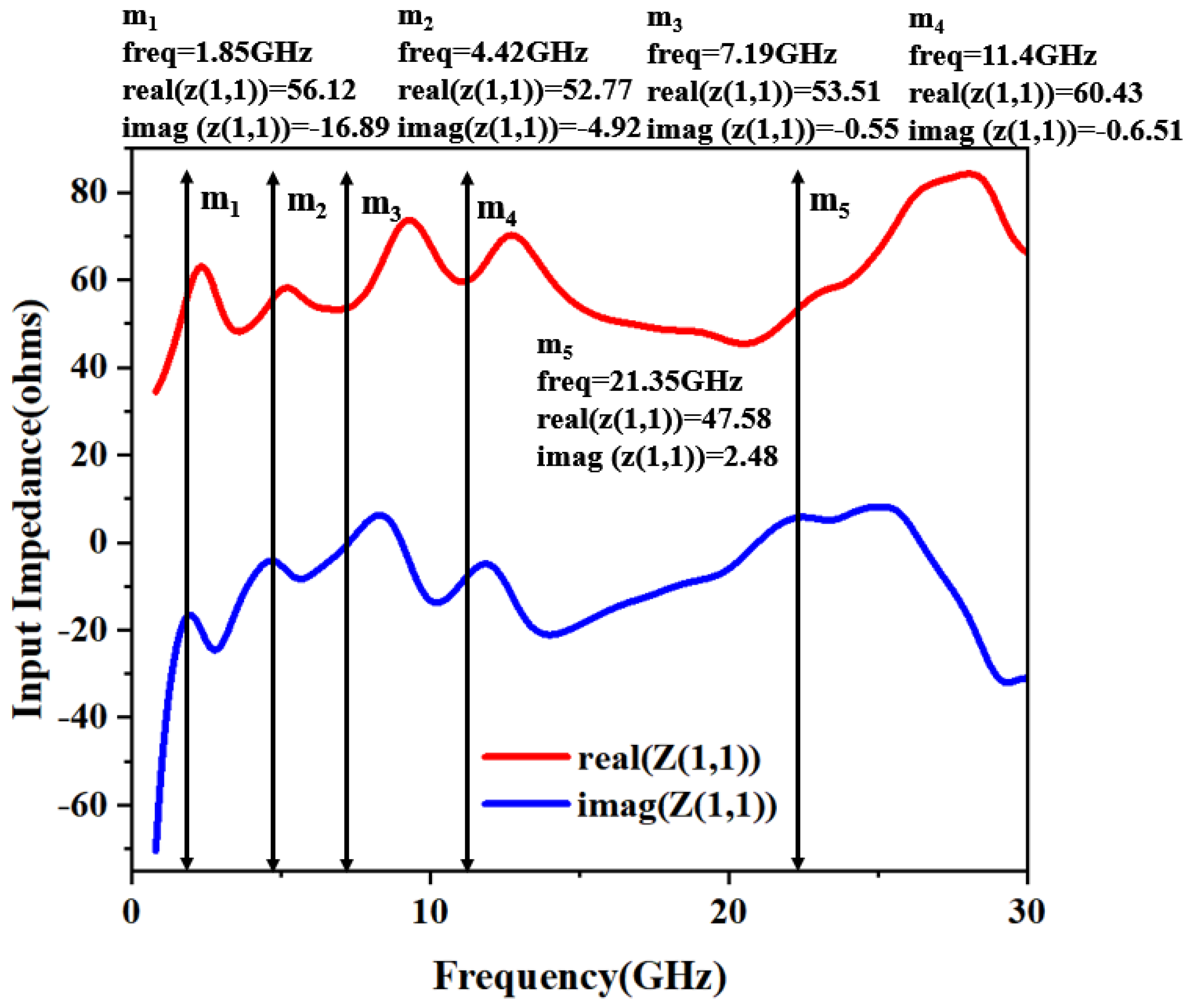

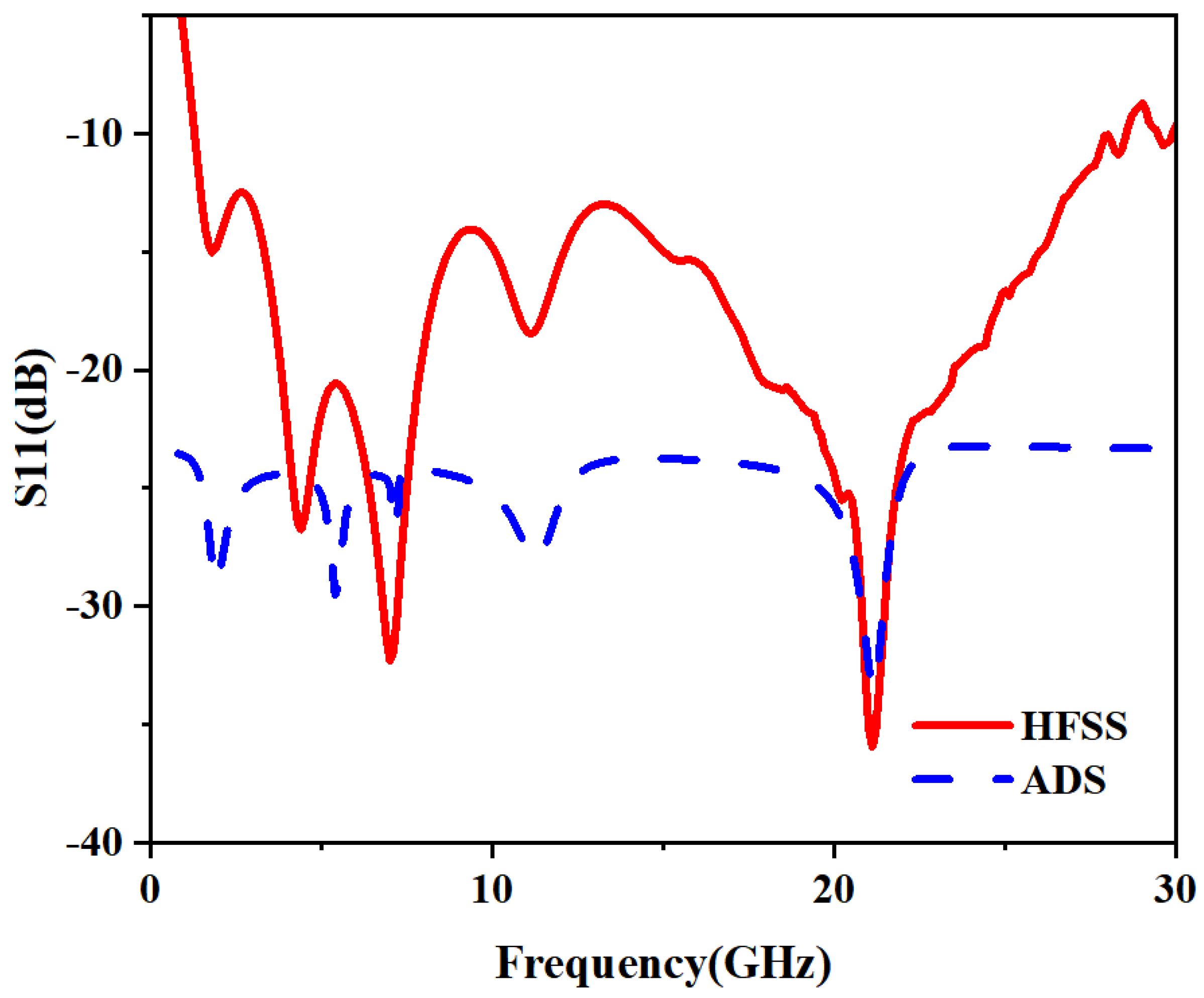



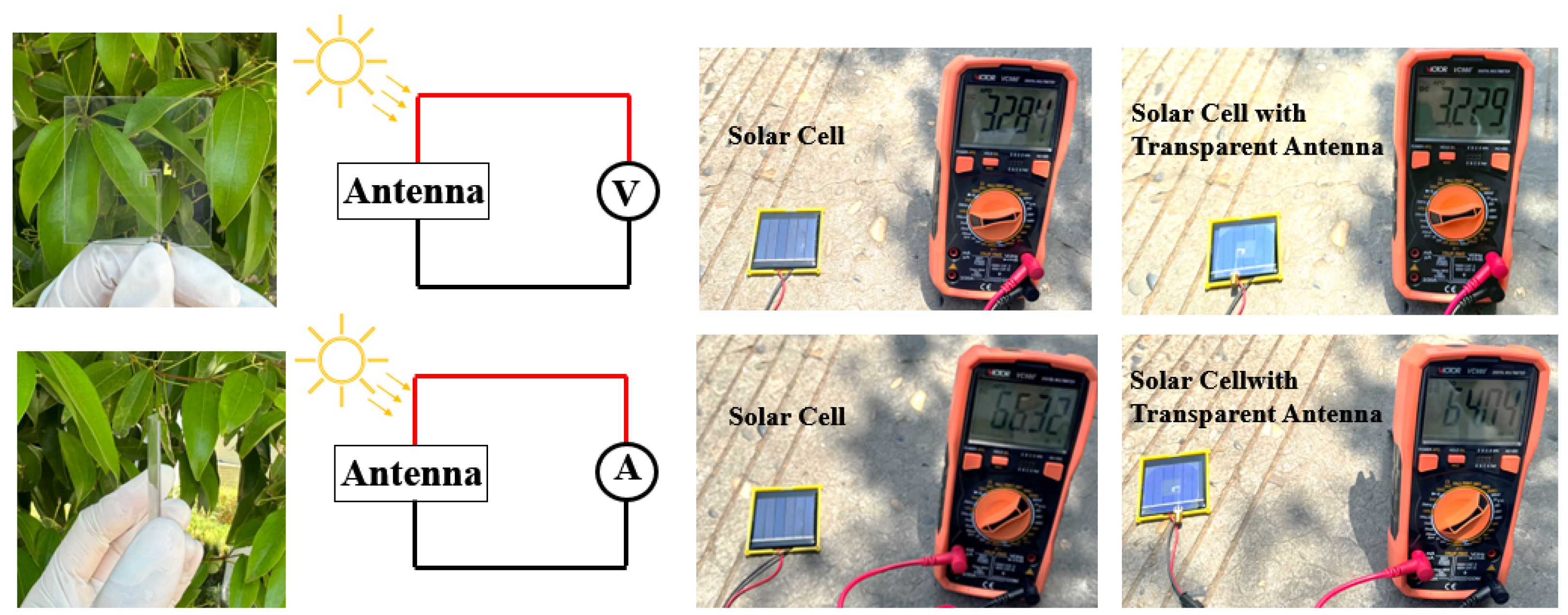
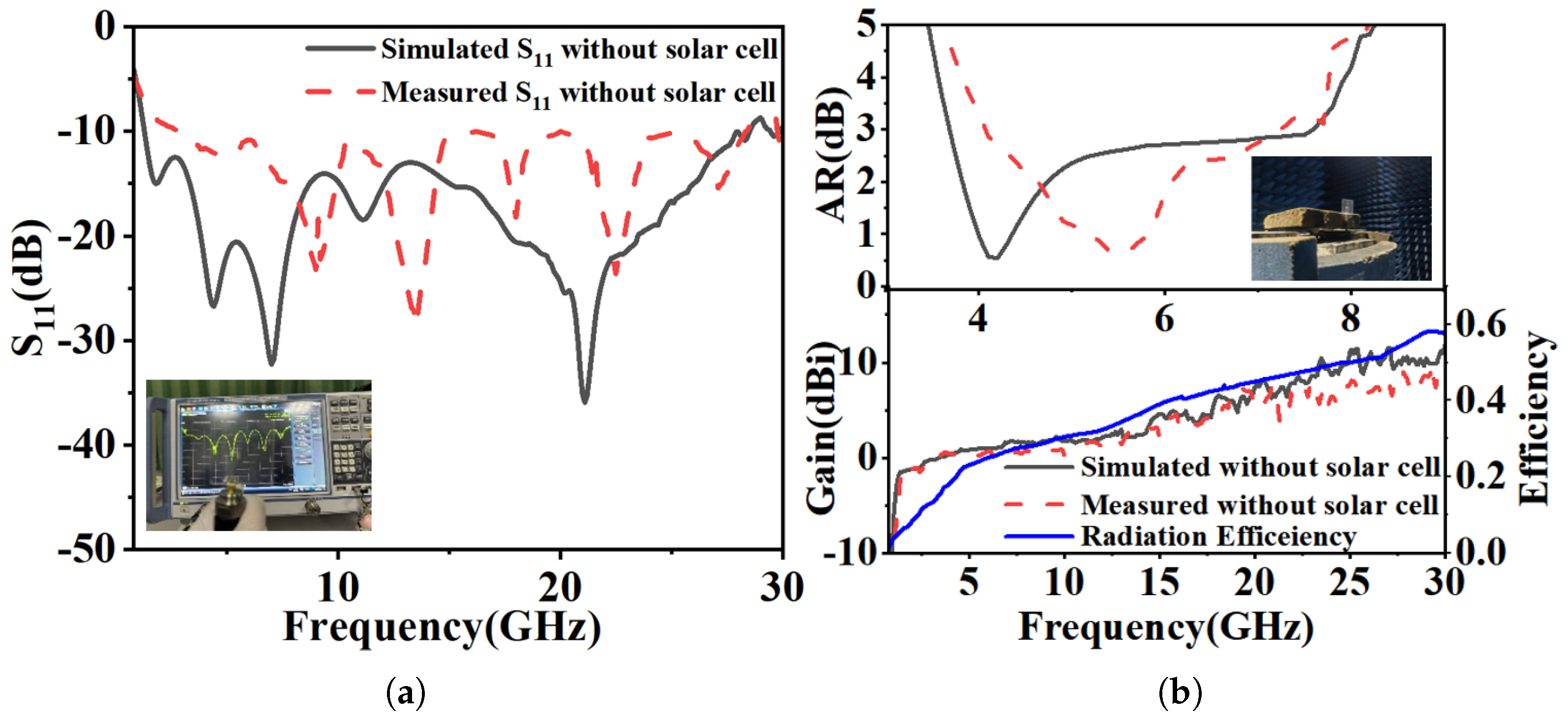

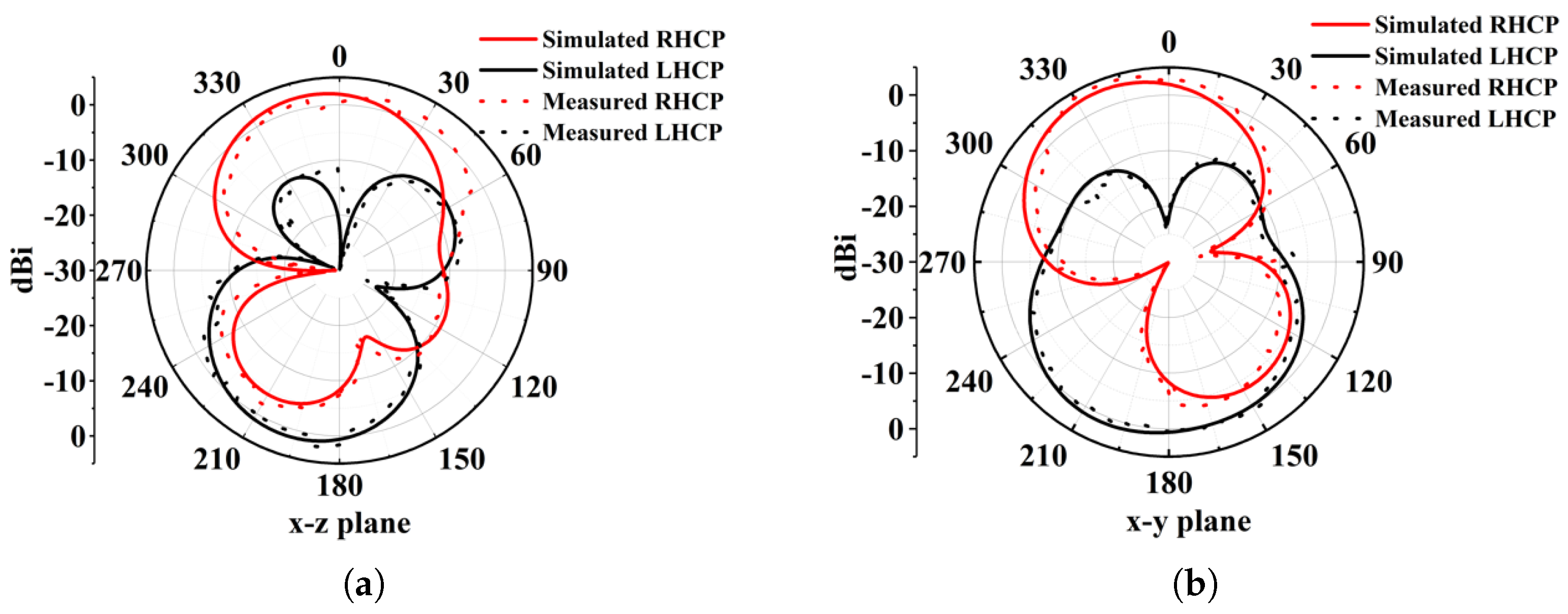
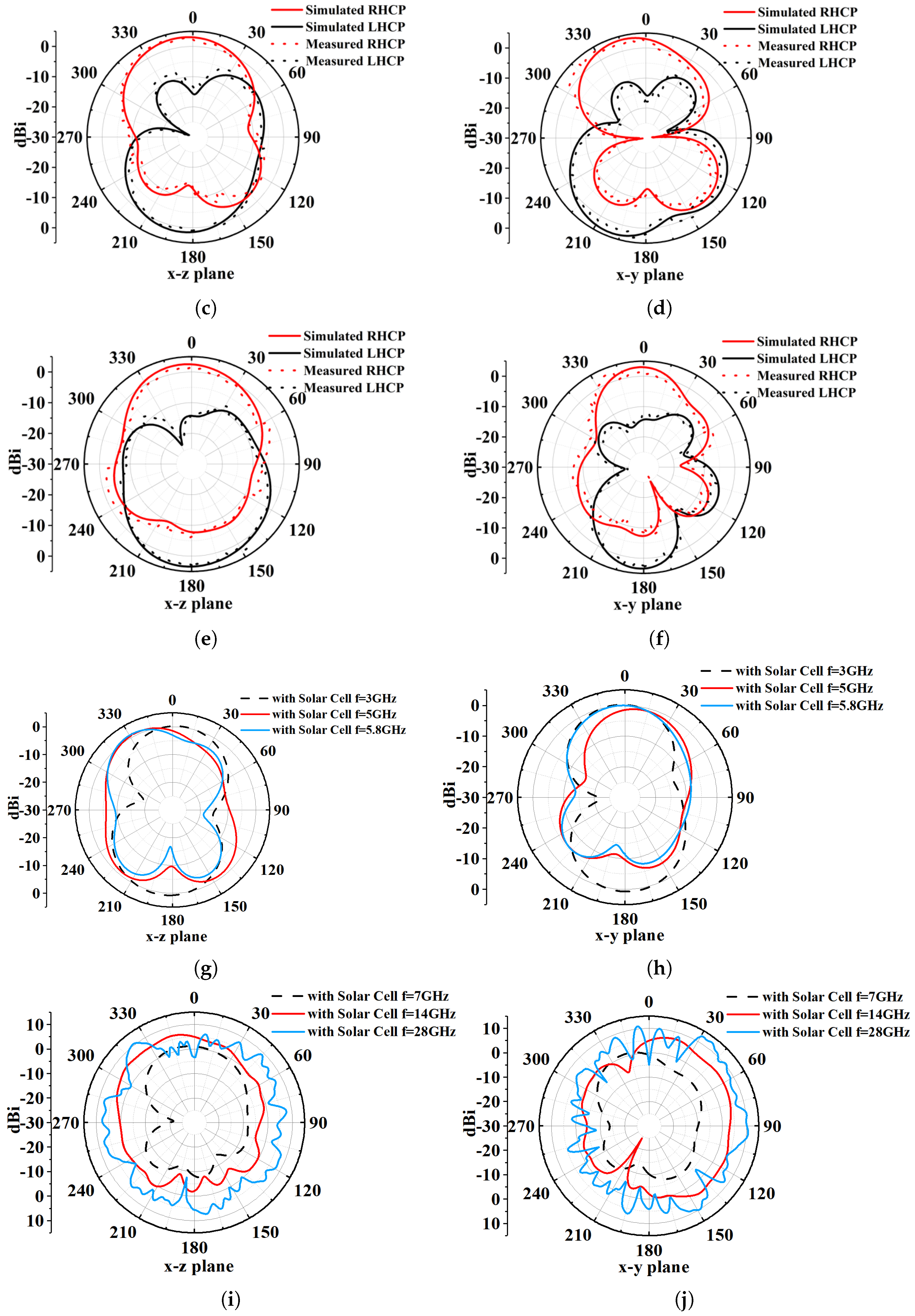

| Parameters | Value | Parameters | Value |
|---|---|---|---|
| W | 45 mm | L | 45 mm |
| h | 0.8 mm | 9 mm | |
| g | 1 mm | 15 mm | |
| 10.85 mm | 5 mm | ||
| 5.7 mm | 19.75 mm | ||
| 22.5 mm | 6.6 mm | ||
| 5 mm |
| Ref. | Size. () | Freq. (GHz) | BW (%) | Substrate | Conductive Layer | Peak Gain | CP (ARBW) | Efficiency | Transp. (%) |
|---|---|---|---|---|---|---|---|---|---|
| [1] [2021] | 0.56 × 0.37 | 1.13–1.71 | 40.8 | Glass | Mesh | 5.3 dBic | Yes (1.06–1.72) | 80% | 95 |
| [3] [2023] | 0.26 × 0.28 | 2.9–29.92 | 164 | Flexi-glass | Copper | 8.1 dBi | No | 90% | 63.3 |
| [24] [2022] | 0.39 × 0.5 | 4–8 | 66.7 | Soda-lime-glass | FTO | 1.2 dBi | No | >46% | 65 |
| [25] [2022] | 0.23 × 0.4 | 2.4–11 | 128 | Soda-lime-glass | FTO/ITO | 2 dBi | No | 60% | 72 |
| [26] [2021] | 0.16 × 0.14 | 1.73–20 | 168 | PET-PVC-PET | ITO | 4.12 dBi | No | 40% | 80.2 |
| [27] [2023] | 0.47 × 0.58 | 3.19–9.30 | 97.83 | PET | AgHT-4 | 2.49 dBi | No | 60% | 70 |
| This Work | 0.2 × 0.2 | 1.33–28.52 | 182 | PET | ITO | 11.5 dBi | Yes (3.88–7.73) | 60% | 90 |
Disclaimer/Publisher’s Note: The statements, opinions and data contained in all publications are solely those of the individual author(s) and contributor(s) and not of MDPI and/or the editor(s). MDPI and/or the editor(s) disclaim responsibility for any injury to people or property resulting from any ideas, methods, instructions or products referred to in the content. |
© 2025 by the authors. Licensee MDPI, Basel, Switzerland. This article is an open access article distributed under the terms and conditions of the Creative Commons Attribution (CC BY) license (https://creativecommons.org/licenses/by/4.0/).
Share and Cite
Rasool, N.; Yang, S.; Chen, C.; Tang, Z.; Huang, K.; Gao, J. A Solar Cell Compatible Super-Wideband Flexible Transparent Antenna with Enhanced Axial Ratio. Micromachines 2025, 16, 1291. https://doi.org/10.3390/mi16111291
Rasool N, Yang S, Chen C, Tang Z, Huang K, Gao J. A Solar Cell Compatible Super-Wideband Flexible Transparent Antenna with Enhanced Axial Ratio. Micromachines. 2025; 16(11):1291. https://doi.org/10.3390/mi16111291
Chicago/Turabian StyleRasool, Nouman, Shuqi Yang, Chen Chen, Zhengming Tang, Kama Huang, and Jinwei Gao. 2025. "A Solar Cell Compatible Super-Wideband Flexible Transparent Antenna with Enhanced Axial Ratio" Micromachines 16, no. 11: 1291. https://doi.org/10.3390/mi16111291
APA StyleRasool, N., Yang, S., Chen, C., Tang, Z., Huang, K., & Gao, J. (2025). A Solar Cell Compatible Super-Wideband Flexible Transparent Antenna with Enhanced Axial Ratio. Micromachines, 16(11), 1291. https://doi.org/10.3390/mi16111291









